 |
|
Royal Rife Machine
.com
Royal
Rife background, history,
inventions, terminology, machines, and more. |
.gif)
|
|
|
|
|
|
|
|
|
Brief History of Royal Raymond Rife

If
you have never heard of Royal Raymond Rife before, prepare to be
angered and incredulous at what this great man achieved for all of
us, only to have it practically driven from the face of the Earth.
Save your final judgment and decision until after
you have read this. Of course, some may regard this as just an amusing
piece of fiction. However, for those who are willing to do some
investigating on their own, they'll see that several
highly-respected doctors and medical authorities who worked with Royal Rife
witnessed, corroborated, and confirmed his incredible findings, as
well as some of the remarkable technical aspects of his creations.
However, in the final analysis, the only real way to determine if such a
revolutionary therapy exists is to experience it yourself.
Royal Raymond Rife, Jr. was born in
Elkhorn, Nebraska on May 16, 1888. His father was a mechanical engineer
by profession and originally was from Ohio. His mother was Ida May
Chaney Rife and was from Dryden, Iowa. When he was 8 months
old his mother died, so his father took him to his sister, Nina Colber Rife Dryden, who raised him. In 1905, at the age of 17, he
graduated from high school and entered John Hopkins University to study
medicine. Later, Rife attended Heidelberg University in
Germany where he developed all of the photomicrographs for the Atlas of
Parasites for the University. The university was so
appreciative of the quality of his work that during 1914 they awarded
him an honorary Doctor of Parasitology degree. Later, in
1936, Rife received an honorary Doctor of Science degree from the
University of Southern California for his work in microscopy and
cancer research.
Rife developed technology which is still
commonly used today in the fields of optics, microscopy, electronics,
radiochemistry, biochemistry, ballistics, and aviation. It is a fair statement that Rife practically developed bioelectric medicine
himself. These break-throughs were well documented in his time by various
newspapers including the LA Times and San Diego Tribune and the
Smithsonian Institute.
He received 14 major awards and
honors, and in
1936 Rife received an honorary Doctor of Science degree from the University
of Southern California. During the 66 years that Rife spent designing
and building medical instruments, he worked for Zeiss Optics, the U.S.
Government, and several private benefactors. Most notable was
millionaire Henry Timkin, of Timkin roller bearing fame. Because Rife
was self-educated in so many different fields, he intuitively looked for
his answers in areas beyond the rigid scientific structure of his day.
He had mastered so many different disciplines that he literally had, at
his intellectual disposal, the skills and knowledge of an entire team of
scientists and technicians from a number of different scientific fields.
So, whenever new technology was needed to perform a new task, Rife
simply invented and then built it himself.
Rife's inventions include a
heterodyning ultraviolet microscope, a microdissector, and a
micromanipulator. When you thoroughly understand Rife's achievements,
you may well decide that he had one the most gifted, versatile,
scientific minds in human history. By 1920, Rife had finished
building the world's first virus microscope.
But how was Rife able to accomplish
this, in an age when electronics and medicine were still just evolving?
Here are a few technical details to placate the skeptics... Rife
painstakingly identified the individual spectroscopic signature of each
microbe, using a slit spectroscope attachment. Then, he slowly rotated
block quartz prisms to focus light of a single wavelength upon the
microorganism he was examining. This wavelength was selected because it
resonated with the spectroscopic signature frequency of the microbe
based on the now-established fact that every molecule oscillates at its
own distinct frequency.
The atoms that come together to form
a molecule are held together in that molecular configuration with a
covalent energy bond which both emits and absorbs its own specific
electromagnetic frequency. No two species of molecule have the same
electromagnetic oscillations or energetic signature. Resonance amplifies
light in the same way two ocean waves intensify each other when they
merge together.
The result of using a resonant
wavelength is that micro-organisms which are invisible in white light
suddenly become visible in a brilliant flash of light when they are
exposed to the color frequency that resonates with their own distinct
spectroscopic signature. Rife was thus able to see these otherwise
invisible organisms and watch them actively invading tissues cultures.
Rife's discovery enabled him to view organisms that no one else could
see with ordinary microscopes.
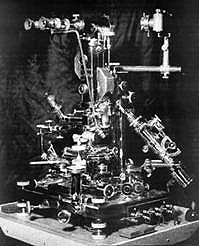
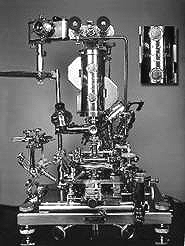
Royal Rife went on to build four
additional models of optical microscopes that were far more powerful
than any others existing during his time... and even up
to present day! It was in the early 1930's that Royal
Rife improved upon and "perfected" the Universal
Prismatic Microscope which had a magnification of 60,000 diameters and a
resolution of 31,000 diameters. (Currently still the most powerful in
the world!) Dr. Rife was the first person to se e LIVING
viruses, since even the most powerful electron microscopes today
kill the organism being observed. In his quest to build this microscope
he developed a method of identifying different organisms and their MOR's
or Mortal Oscillatory Rates. This meant that each organism had a
signature frequency at which it vibrated or resonated. Rife further
developed this technology by building a frequency instrument which was
able to reproduce these MOR's and thus kill the organisms.
Royal Rife's Universal
Prismatic Microscope
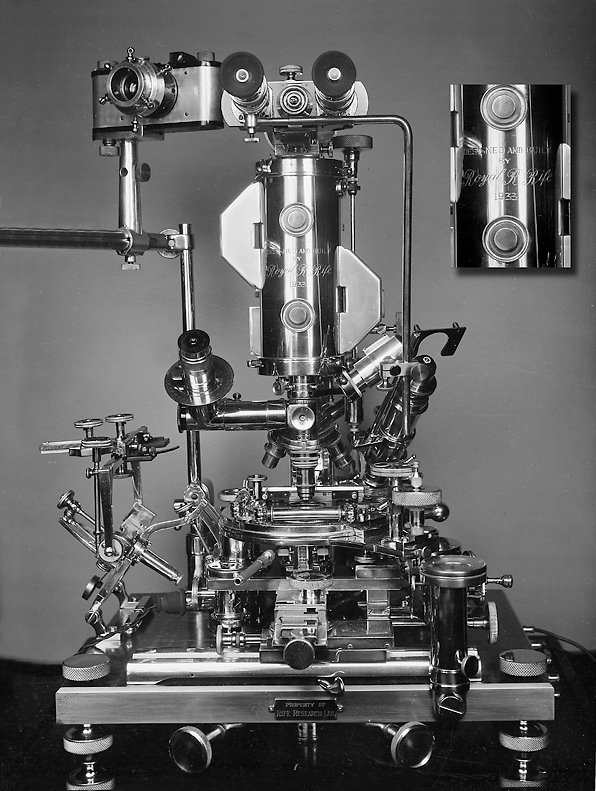
The theory can be explained using an
analogy of an opera singer who uses her voice to shatter a crystal
glass. The glass is vibrating at a certain frequency and when the opera
singer sings at that particular frequency the glass shatters in the same
way as the organism shattering when it is exposed to the frequency
generated by the Rife machine.
During 1912, Rife moved to San Diego,
California where he established his first research laboratory. During
that same year he married Mamie Quill. It is reported that Rife worked
with the United States Navy before and during World War I, and that he
was commissioned as a Lt. Commander USNR. Rife
and his wife traveled extensively in regard to his connections with the Zeiss firm to and from Europe right before the war.
During the years just prior to the great depression Dr. Rife worked for
both the United States Government and the Carl Zeiss Optics firm. He was
reported to also have received a Research Fellowship in Biochemistry
from the Andean Anthropological Expedition Institute, so he was
obviously doing private research on his own. Some of his technological
inventions are still used today in the fields of optics, electronics,
radiochemistry, biochemistry, ballistics and aviation. At some point in
time his financial base dissolved and he took a job as chauffeur for
multi-millionaire Henry Timkin. Rife and his wife moved into an
apartment located above Timkin's garage. When Timkin learned of some of
Dr. Rife's talents, he had Rife build an engine for a speedboat named
the Kitty Hawk that Timkin owned. This engine developed 2700 horsepower
and pushed the boat for a record breaking one hundred miles at an
average speed of 87 miles per hour. It is said that Dr. Rife held a
speed record on power boats, so there is a possibility that Rife drove
the boat as well as built the engine.
Royal Rife's contact with Henry
Timkin worked well for both of them. Timkin manufactured roller
bearings. Bearings were breaking down in his finished products due to
irregularities in the steel used to create the bearings. Rife designed
and built an X ray machine that checked every bearing coming out of the
plant and rejected every faulty bearing before it could be sent out as a
finished product. This saved the company millions of dollars. Timkin was
so pleased that he set up a monthly lifetime payment to Rife for
producing the specialized X ray machine for his production environment.
Mrs. Timkin was ill. The illness
kept getting worse and her doctors were unable find the cause of her
problem. Dr. Rife suspected that it might be something she was eating.
He made a search of her kitchen and, with his microscope, was able to
find the bacteria in her spice cabinet that was making her ill. With the
source eliminated, her illness disappeared. Amelia C. Bridges, Henry
Timkin's sister and business partner's wife, also suffered from a
continuing physical problem. Dr. Rife was able to work with her and
discovered the source of her illness. When she died in 1940 she left Dr.
Rife $50,000 to continue his work.
Henry Timkin and his partner, Bridges were so impressed with Royal Rife
and his work that they set up a fund to finance a completely equipped
laboratory at Point Loma, California and to carry the expenses of a
research program in the laboratory. This was the platform that Rife
could use to employ the talent and knowledge he had cultivated and
developed over all of the years of his education and experience. This
was where he worked and made his discoveries. It is said that Rife had
as many as twelve laboratory assistants working for him at this time.
The microscopes he built allowed him
to watch a live virus and to observe it in its changing life forms, thus
proving that microbes and virus have the ability to change from one form
to another depending upon the medium they are in. Several famous
physicians of his day from Northwestern University, Mayo's clinic and
others worked with him and his microscopes and confirmed his work. He
would sometimes work for as long as twenty hours to get a virus in
focus. The problem of focusing the microscopes caused some physicians
who were invited to observe what could be done with his microscopes to
never be able to see a virus.
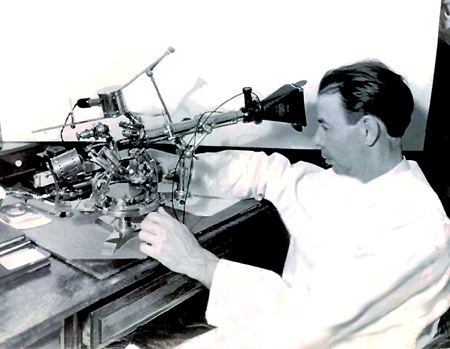
The
Universal Prismatic Microscope which he presented to the world in 1933
was (is) the most powerful optical microscope ever made, and it was also the most versatile. The Universal used all types
of illumination: polarized, monochromatic or white light, dark field,
slit ultra and infra-red. It could be used for all manner of microscopical work, including petrological work or for crystallography
and photomicrography. According to a report submitted to the Journal of
the Franklin Institute it had a magnification of 60,000x, and a
resolution of 31,000x. The ocular of this instrument was binocular, but
it also had a detachable segment lower in the body for monocular
observation at 1800x (x=power) magnification.
Again, one of the most attractive features
of this microscope is that, in contrast to the Electron Microscope, the
Universal Microscope does not kill the specimens under observation and
affords observation of natural living specimens in all circumstances,
meaning it does not rely on fixing or staining to render visibility or
definition.
Rife achieved this by using various
modes of lighting to bring virus into visibility in their natural
colors. He first turned to this technique of using light to stain the
subjects because he realized that the molecules of the chemical stains
were much too large to enter into the structures he sought to visualize.
Furthermore, the typical stains used in microscopy are sometimes lethal
to the specimens and he wished to see them in their live state.
One factor enabling these natural
images was Rife's use of a device called a Risley counter-rotating
prism. This consists of two circular, wedge shaped prisms, mounted face
to face and set in a geared-bezel, and so geared as to turn each prism
through 360 degrees in opposite directions by means of an extended
handle. Rife built a special mount under the stage to accommodate these
instruments, and through which he directed a powerful monochromatic beam
from his patented lamp. At various declinations of the refracted and
polarized ray normally invisible bodies would become visible in a color
peculiar to their structure or chemical make-up. All optical elements in
this microscope were made of block quartz, which permits the passage of
ultraviolet rays.
By this means Rife revealed that
virus and bacterium have a natural range of refraction to various light
environments. This suggested that organisms could be classified by their
index of refraction in the Risley prism under the Universal Microscope.
Rife began research work on
tuberculosis circa 1920. In a short time, it became apparent to Rife
there was something else involved in this disease below the level of the
bacterium. This spurred his work in developing his "virus" microscopes,
of which two preceded the Universal, which is sometimes called the
number 3 Rife microscope. Rife was the first person known to have
isolated and photographed the tuberculosis virus, as well as many
others. Eventually, Rife also succeeded in isolating a virus specific to
cancer, finding it gave off a distinctive purple-red emanation. This
virus he named the BX virus: Bacillus X, found in every instance of
carcinoma he examined.
With the assistance of Dr. Arthur I.
Kendall, using a special medium Kendall had developed for culturing
virus, they succeeded in culturing the BX virus. They had little success
at first until Rife accidentally left a tube in the glow of an ionizing
lamp. He noticed the tube had clouded, indicating activity. Then they
performed the culture in a partial vacuum, or anaerobic environment and
stimulated them with the ionizing light. Their work was the first
successful culturing of virus outside a living host.
Rife extracted the cancer virus
from an unulcerated, human breast mass. He filtered, cultured and recultured these over 10 times over a 240 hour period. They injected the
last generation culture into the breast region of a live rat. The rat
would inevitably develop a tumor. Rife would then remove the tumor,
extract the virus, and repeat the process. He did this over four hundred
times removed from the original sample, proving categorically that the
BX virus induced cancerous tumors in every instance.
Dr. Royal Rife performed more than
400 experiments where he implanted a cancer virus in a mouse and when a
tumor had grown in the mouse he carefully removed the tumor and found
the same cancer virus in the tumor. He never experimented with humans.
After Dr. Rife had learned to see a virus the next obvious goal became
to devise a method to destroy the virus or microbe without damage to the
host.
Since the days of Dr. Nikola Tesla, men of science had known of the
connection of electrical, magnetic and radio frequencies within the
operation of the human body, so Rife turned to electro-magnetic
frequencies since he could expose the bacteria and virus to such
frequencies and watch the effects. He discovered that each microbe and
each virus had a particular frequency to which it was vulnerable. Rife
called this the ""mortal oscillatory rate", a term still used to this
day. Over and over again he would watch and see the virus destroyed when
a certain frequency was applied. He made up charts showing which
frequency settings would destroy which microbe or virus. Experimenters
are still using those frequencies today, but few today have the means to
see what effect the frequencies are having on the virus or microbe they
are trying to destroy. The microscopes that Rife had built were
fundamental to his success and without his microscope there would have
been no treatment.
|
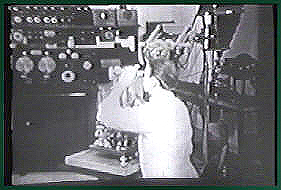 |
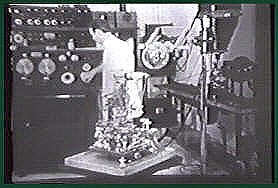 |
|
Dr. Royal Rife
identifying and studying an organism on the Universal #3
Microscope. |
Dr. Royal Rife killing or
disabling the organism with his beam ray frequency device.
The large phanotron plasma tube is above the Universal #3
Microscope. |
|
|
|
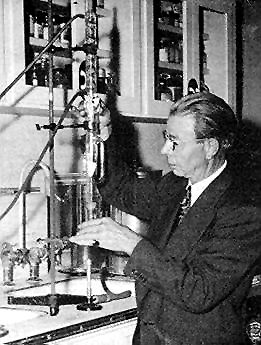
Dr. Rife began obtaining a wide variety of malignant tissues during
1931. Dr. Rife obtained more and diverse tumors from more clinical
sources. 20,000 of these tissue samples were obtained and cultured. It
was from the study of these cultures that he found a consistent virus in
every cancer tissue. He named it the BX virus. Both Dr. Rife and Dr.
Kendall successfully demonstrated the isolation of the BX virus to more
than 50 research pathologists associated with noteworthy institutions
nationwide.
In the course of his experiments Dr.
Rife discovered that the successful operation of the microscopes
depended upon the use of ultraviolet light. He also discovered that the
ultra-microscope did not require the fixation, (staining or special
preparation), of the specimen before viewing. Dr. Kendall, a renowned
pathologist from Northwestern University Medical School contributed a
medium that he had developed which allowed both scientists to observe,
demonstrate and photograph filterable viruses during 1931. It was also
by using this medium that allowed both scientists to observe and prove
the characteristic of pleomorphism of viruses changing from one form to
another by changing the medium they occupied. Without the
ultra-microscope it would not have been possible to prove that such a
change was possible and that such an action took place and had been
taking place down through the ages. This phenomena had given the medical
profession a mystery that had not been understood before and is still not generally accepted or even considered by the US medical
establishment.
On November 3, 1929 the San Diego
Union reported on the progress of Rife's work. During June 1931, Popular
Science magazine tells Americans, nationwide, about Royal Rife and his
treatments. During this period of time many articles and news stories
appeared regarding these remarkable accomplishments. Physicians in the
Southern California area began to hear of Rife and his work. They came
from all over the United States to observe what he was doing and verify
his results.
Newspapers
Feature Royal Rife and His Machines
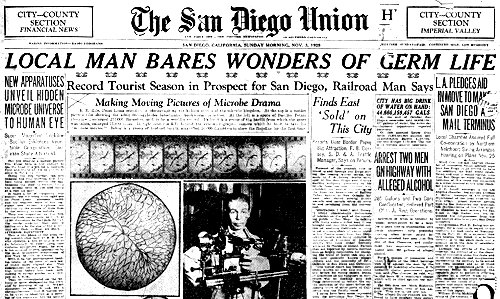
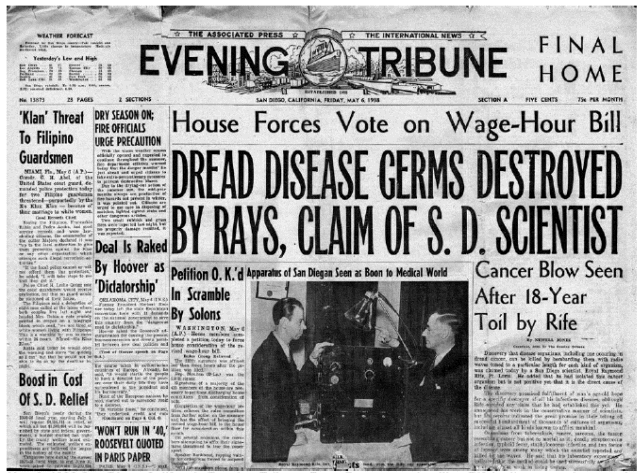
During
November 1931, Dr. Milbank Johnson invited 44 Los Angeles area
physicians to his home in Pasadena, California to honor Rife for the
work he was doing. Dr. Royal Rife was honored as the man who had
discovered a way to end all disease at this meeting. The banquet was
called "The End Of All Disease" and the doctors who attended were Dr.
Arthur I. Kendall, Dr. George Dock, Dr. S. Fosdick Jones, Dr. O.O.
Witherbee, Dr. C.M. Hyland, Dr. Harold Witherbee, Dr. Alvin G. Foord,
Dr. B.O. Raulston, Dr. V.L. Andrews, Dr. Linford Lee, Dr. Milbank
Johnson, Dr. George Kress, Dr. Rufus B. Von klein Scmidt, Dr. Albert
Ruddack, Dr. Wayland Morrison, Dr. Richard Winter, Dr. F.C.E. Mattison,
Dr. M. Aubrey Davidson, Dr. Joseph Heitger, Dr. W.H. Sooins, Dr. E.M.Hal
l, Dr. Walter V. Breem, Dr. C.W. Bonynge, and also invited were Dr.
E.W. Butt, Dr. C.E. Zobell, Dr. A.S. Heyt, Dr. B. Winter Gonin, Dr. E.W.
Lanson, Dr. 0.C. Grunner, Dr. A.H. Zeiler, Dr. James B. Couche, Dr. R.W.
Hammack, Dr. K.F. Meyer, Dr. C.D. Maner, Dr. Arthur W. Yale, Dr. Ellis
Jones, Dr. E.L. Walker, Royal R. Rife, Dr. E.C. Rosenow, Sr., Dr. Allen
B. Kanaval, Dr. E.F.F. Copp, Dr. Sanwel J. Tattison, Dr. Royal Lee, Dr.
J. BrandonBruner, and Dr. Lee DeForest.
In 1934, a group of
physicians led by Dr. Milbank Johnson of Pasadena, California, in an
experiment that was sponsored by the University of California, which
brought 16 terminally ill patients from a hospital in San Diego and
placed them in apartments on the Scripps estate at La Jolla, California
where they were treated by being subjected to the frequencies
recommended by Dr. Royal Rife for a period of ninety days.
Fourteen of
the patients were declared free of any cancer at that time. The other
two required an additional month of treatment to be completely cured.
During 1939 Dr. Rife was formally
invited to address the royal Society of Medicine in London, England,
which had recently verified his findings. He also received invitations
to speak in France and Germany. Dr. R. Seidel reported and formally
announced the Rife Ray Tube system therapy for the treatment of cancer
in the journal of the Franklin institute in February 1944. Dr. Rife's
treatments of virus and bacterial infections and his microscopes were
described and praised by the Smithsonian Institute in an article
published in the Institute's publication during 1944.
Now enters the American
Medical Association...
A
man named Morris Fishbein, head of the AMA, (Fishbein had
acquired the entire stock of the American Medical Association by 1934)
heard of this discovery, and subsequently
sent an attorney to Rife with 'an offer you can't refuse.' Rife refused.
We may never know the exact terms of this offer. However, we do
know about a similar scenario and offer made to another scientist
named Harry Hoxsey, who had created an herbal remedy for cancer. Fishbein
and his associates would receive ALL profits
for nine years and Hoxey would receive nothing. Then, if they were
satisfied that it worked, Hoxsey would begin to receive just 10% of the
profits. Hoxsey decided that he would rather continue to make all the
profits himself. When Hoxsey turned Fishbein down, Fishbein used
his immensely powerful political connections to have Hoxsey arrested 125
times in a period of 16 months. The charges (based on practice without a
license) were always thrown out of court, but the harassment drove
Hoxsey insane.
Fishbein must have realized that
this strategy would backfire with Rife. First, Rife could not be
arrested like Hoxsey for practicing without a license. A trial on
trumped-up charges would mean that testimony supporting Rife would be
introduced by prominent medical authorities working with Rife. And the
defense would undoubtedly take the opportunity to
introduce evidence such as the 1934 medical study done with USC. The
last thing in the world that the pharmaceutical industry wanted was a
public trial about a painless therapy that cured 100% of the terminal
cancer patients and cost nothing to use but a little electricity. It
might give people the idea that they didn't need drugs.
By
this time, Rife and associates had set up a corporation called the Ray Beam Tube
Corporation to manufacture Rife's machine. He had brought electrical
engineer Phillip Hoyland into the company to handle production. Fishbein allegedly
financed Hoyland to bring a lawsuit against Rife, and ultimately after a
long and expensive legal battle brought about the end of production. Rife
won
the lawsuit, but the cost of the suit caused the financial destruction
of the company. Rife was emotionally destroyed by his treatment in court
and his entire program eventually dissolved.
Curious side note: a laboratory located in New Jersey
that was repeating Rife's work 'surprisingly' burned during March 1939,
just as scientists there were preparing to announce confirmation of Rife's work. Many
papers in Rife's laboratory in San Diego also disappeared, as did parts of
his precious microscopes.
Physicians using his treatment
program were threatened by the American Medical Association and the
State of California with the loss of their licenses if they continued on
the program.
Many scientists and
doctors had publicly confirmed Rife's discovery of the cancer virus and
its pleomorphic nature, using darkfield techniques, the Naessens
microscope, and laboratory experiments. Rife also worked with the top
scientists and doctors of his day who also confirmed or endorsed various
areas of his work. They included: E.C. Rosenow, Sr. (longtime Chief of
Bacteriology, Mayo Clinic); Arthur Kendall (Director, Northwestern
Medical School); Dr. George Dock (internationally-renowned); Alvin Ford
(famous pathologist); Rufus Klein-Schmidt (President of USC); R.T. Hamer
(Superintendent, Paradise Valley Sanitarium; Dr. Milbank Johnson
(Director of the Southern California AMA); Whalen Morrison (Chief
Surgeon, Santa Fe Railway); George Fischer (Childrens Hospital, N.Y.);
Edward Kopps (Metabolic Clinic, La Jolla); Karl Meyer (Hooper
Foundation, S.F.); M. Zite (Chicago University); and many others.
But by 1939, almost all of these
distinguished doctors and scientists were denying that they had ever met
Rife. What happened to make so many brilliant men have complete memory
lapses?
Later, Arthur Kendall, the Director of
the Northwestern School of Medicine who worked with Rife on the cancer
virus, accepted almost a quarter of a million dollars to suddenly
'retire' in Mexico. That was an exorbitant amount of money in the Depression.
Then, Dr. George Dock ( another prominent figure who collaborated with Rife)
was silenced with an enormous grant, along with the highest honors the
AMA could bestow. Between the carrots and the sticks, everyone
except Dr. Couche and Dr. Milbank Johnson gave up Rife's work and went
back to prescribing drugs.
To finish the job, the medical
journals, support almost entirely by drug company revenues and
controlled by the AMA, refused to publish any paper by anyone on Rife's
therapy. Therefore, an entire generation of medical students graduated
into practice without ever once hearing of Rife's breakthroughs in
medicine.
The magnitude of such an insane crime
eclipses every mass murder in history. Cancer picks us off quietly...but
by 1960 the casualties from this tiny virus exceeded the carnage of all
the wars America ever fought. In 1989, it was estimated that 40% of us
will experience cancer at some time in our lives.
In Rife's lifetime, he had witnessed
the progress of civilization from horse-and-buggy travel to jet planes.
In that same time, he saw the epidemic of cancer increase from 1 in 24
Americans in 1905 to 1 in 3 in 1971 when Rife died.
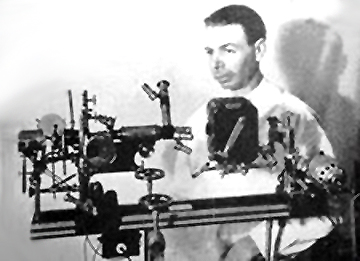
He also witnessed the phenomenal
growth of the American Cancer Society, the Salk Foundation, and many
others collecting hundreds of millions of dollars for diseases that were
cured long before in his own San Diego laboratories. In one period,
176,500 cancer drugs were submitted for approval. Any that showed
'favorable' results in only one-sixth of one percent of the cases being
studied could be licensed. Some of these drugs had a mortality rate of
14-17%. When death came from the drug, not the cancer, the case was
recorded as a 'complete' or 'partial remission' because the patient
didn't actually die from the cancer. In reality, it was a race to see
which would kill the patient first: the drug or the disease. The
inevitable conclusion reached by Rife was that his life-long labor and
discoveries had not only been ignored but probably would be buried with
him. At that point, he ceased to produce much of anything and spent the
last third of his life seeking oblivion in alcohol. It dulled the pain
and his acute awareness of half a century of wasted effort - ignored -
while the unnecessary suffering of millions continued so that a vested
few might profit. And profit they did, and profit they do.
It has been written that after the
loss of his lab and due to the mental and emotional results of the
lawsuit, Rife became an alcoholic and did nothing really important with
the rest of his life. During the 1950's Rife tried to develop energy
instruments with research partner John Crane, who eventually ended up with title
to the microscopes that still existed, but with no record of them being
in working order. During 1960 Medical authorities invaded
Crane's lab and destroyed his existing instruments and records. (Note:
All remaining equipment and notes owned by Crane were bequeathed to
Ron Rockwell of Rockwell Scientific Research, who later built and
sold the RPG900 frequency generator.) John
Crane was eventually indicted by the State of California for "fraud" and sent to
prison. (More FDA/AMA bull crap!) Rife is said to have gone to Mexico at this time. Dr. Royal Rife
died on August 11, 1971 at Grossman Hospital in El Cajon, California of
a heart attack after spending the last year of his life in an El Cajon
nursing home. He was without friends or funds. That was not a proper way
to reward a true American hero.
For more on the continued sage of
the "Rife machine", see the John Crane page
here.
Why, Why, Why?
Imagine, for a moment, that you have
spent more than two decades in painfully laborious research-- that you
have discovered an incredibly simple, electronic approach to curing
literally every disease on the planet caused by viruses and bacteria .
Indeed, it is a discovery that would end the pain and suffering of
countless millions and change life on Earth forever. Certainly, the
medical world would rush to embrace you with every imaginable accolade
and financial reward imaginable. You would think so, wouldn't you?
Unfortunately, arguably the greatest medical genius in all recorded
history suffered a fate literally the opposite of the foregoing logical
scenario. In fact, the history of medicine is replete with stories of
genius betrayed by backward thought and jealously, but most
pathetically, by greed and money.
In the nineteenth century, Dr. Ignaz
Semmelweiss struggled mightily to convince surgeons that it was a good
idea to WASH THEIR HANDS, sterilize their instruments and use sterile surgical procedures.
Pasteur was ridiculed for years for his theory that germs could cause
disease. Scores of other medical visionaries went through hell for
simply challenging the medical status quo of day, including such legends
as Roentgen and his X-rays, Morton for promoting the 'absurd' idea of
anesthesia, Harvey for his theory of the circulation of blood, and many
others in recent decades including: W.F. Koch, Revici, Burzynski,
Naessens, Priore, Livingston-Wheeler, and Hoxsey. Orthodox big-money
medicine resents and seeks to neutralize and/or destroy those who
challenge its beliefs.
The point is... often, the
visionary who challenges the status quo usually pays a
heavy price for his 'heresy.' You have just discovered a new therapy
which can eradicate any microbial disease but, so far, you and your
amazing cure aren't very popular. What do you do next? Well, certainly
the research foundations and teaching institutions would welcome news of
your astounding discovery. Won't they be thrilled to learn you have a
cure for the very same diseases they are receiving hundreds of millions
of dollars per year to investigate? Maybe not, if it means the end of
the gravy train. These people have mortgages to pay and families to
support. On second thought, forget the research foundations.
Perhaps you should take your
discovery to the pharmaceutical industry; certainly it would be of great
interest to those protectors of humanity, right? But remember, you have
developed a universal cure which makes drugs obsolete, so the
pharmaceutical industry just might be less than thrilled to hear about
your work. In fact, the big shots might even make it certain that your
human disease-ending technology never sees the light of day, by
preventing it from becoming licensed by the regulatory agencies. Now,
assuming your amazing cure is an electronic instrument, the only cost of
using it is electricity. And it is absolutely harmless to patients, who
can recover without losing their hair, the family home, and their life
savings. So, with your technology, there is no longer any reason for
people with cancer to pay over $300,000 per patient -- to become deathly
ill from chemotherapy, radiation treatments, and the mutilation of
surgery. It sounds like you won't find many friends and support among
practicing oncologists, radiologists, and surgeons, doesn't it?
You might try the hospitals and big
clinics. But how thrilled are they going to be about a therapy
administered in any doctor's office; which reverses illness before the
patient has to be hospitalized? Thanks to you, the staffs of these
institutions will essentially be out of work. Well then, how about the
insurance companies? Surely, they would be delighted to save the expense
of hospitalization - at least the companies which haven't invested in
hospitals, where the staff is now sitting around waiting for someone to
break a leg or be in a car accident...and the ones who don't lose
policyholders as a result of your invention...and the companies which
aren't trying to divest their pharmaceutical stock. Oh well, forget the
insurance companies, too.
It looks like you just might have a
little problem with the medical establishment, no?
Probably the only friends you'll have
will be the patients and those progressive doctors who see change as an
opportunity, rather than a threat to their established money-making
monopoly. Those people will love you. But they don't call the shots.
What follows, now, is the story of exactly such a sensational therapy
and what happened to it. In one of the blackest episodes in recorded
history, this remarkable electronic therapy was sabotaged and buried by
a ruthless group of men.
Today....
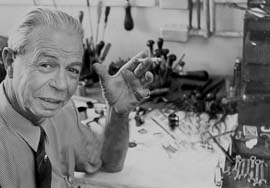
In 1971, Royal Rife died at the age of 83.
It is reported that his demise was related to heartbreak knowing his
cure was going to be squashed completely by the powers that be,
along with a combination of valium and alcohol.
Fortunately, his death was not the end of his
electronic therapy. It has re-emerged in the underground
medical/alternative health world only since the mid-80's, as a few humanitarian doctors and engineers
reconstructed his frequency instruments and kept his genius alive. Rife
technology became public knowledge again in 1986 with the publication of
The Cancer Cure That Worked, by Barry Lynes, and other material about
Royal Rife and his monumental work.
There is wide variation in the
cost, design, and quality of the modern portable Rife frequency
research instruments available. Costs vary from about $1200 to $5500
with price being no legitimate indicator of the technical competence
in the design of the instrument or performance of the instrument.
Some of the most expensive units have serious technical limitations
and are essentially a waste of money. At the other extreme, some
researchers do get occasional, rather crude results from inexpensive simple, unmodified
frequency generators, but this is just as much as 'dice roll' as
some of the expensive ones. Without the proper modifications, the basic frequency
generator can only show minimal and inconsistent results. Please recall
that the actual destruction of the viruses and bacteria, etc. is not
accomplished by the frequency alone that is displayed on these generators,
but by certain harmonics of
that particular frequency combined with a carrier frequency, which
is not included on most of the more basic and rudimentary instruments
being marketed. As they say,
"let the buyer beware".
One day, the name of Royal Raymond
Rife may ascend to its rightful place as the giant of modern medical
science. Until that time, his fabulous technology remains available only
to the people who have the interest to seek it out. While perfectly
legal for veterinarians to use to save the lives of animals, Rife's
brilliant frequency therapy remains taboo to orthodox mainstream
medicine because of the continuing threat it poses to the international
pharmaceutical medical monopoly that controls the lives - and deaths -
of the vast majority of the people on this planet.
Royal Raymond Rife, Jr.
May 16, 1888 - August 11, 1971
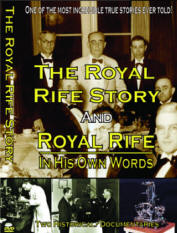
Royal Rife Story on DVD
If
you truly wish to know as much
as you can about the complete
history of Royal Rife; his amazing
devices; how they worked; how
many of today's frequencies were
determined; and much
more, we urge you to visit
www.rifevideos.com.
This is one the most
comprehensive and painstakingly
detailed sources of information
on the topic.
(click the image to watch now) |
For 20 Years
We've Offered the Best Rife Machine We've Seen.
Unfortunately, we are not able to display the generator up close
here due to
certain FDA and contractual restrictions,
but we
can
email you the information
immediately.
Just email us now and an 'Auto-Reply' will
send you a site to see it up close. Check
your spam folder if you don't see it.
We do not
share your email and we will not spam
you.
|
.png)
Royal Rife
|
|